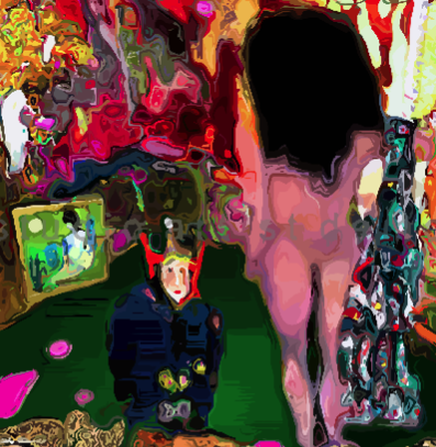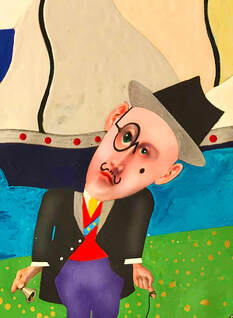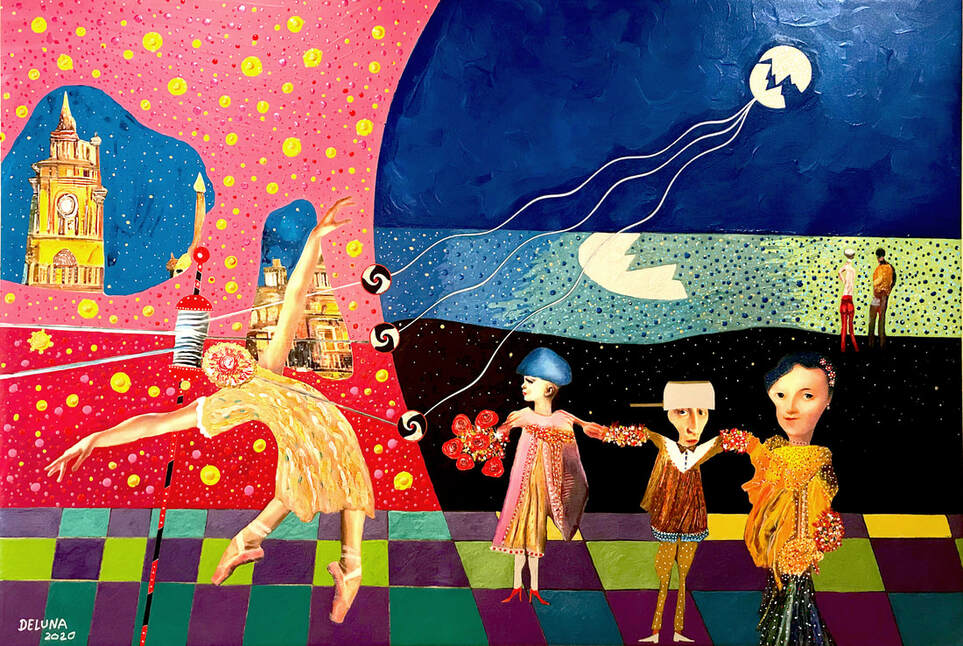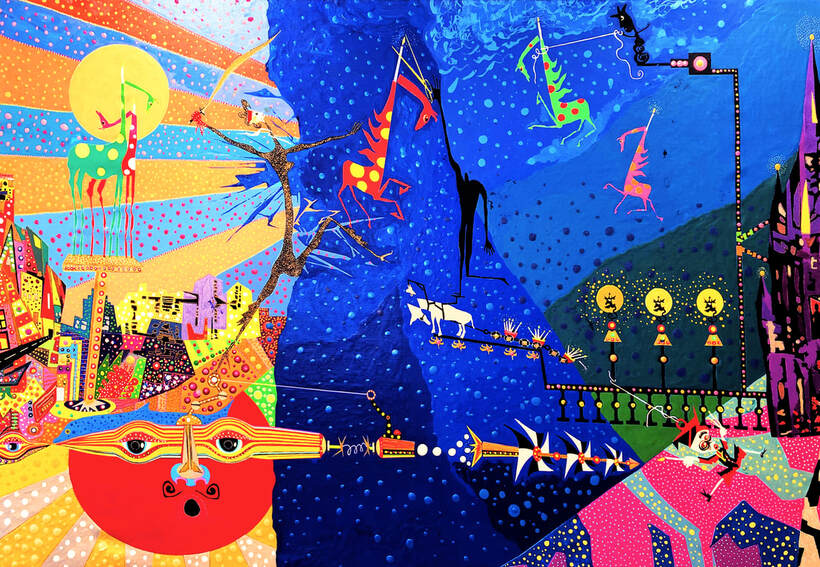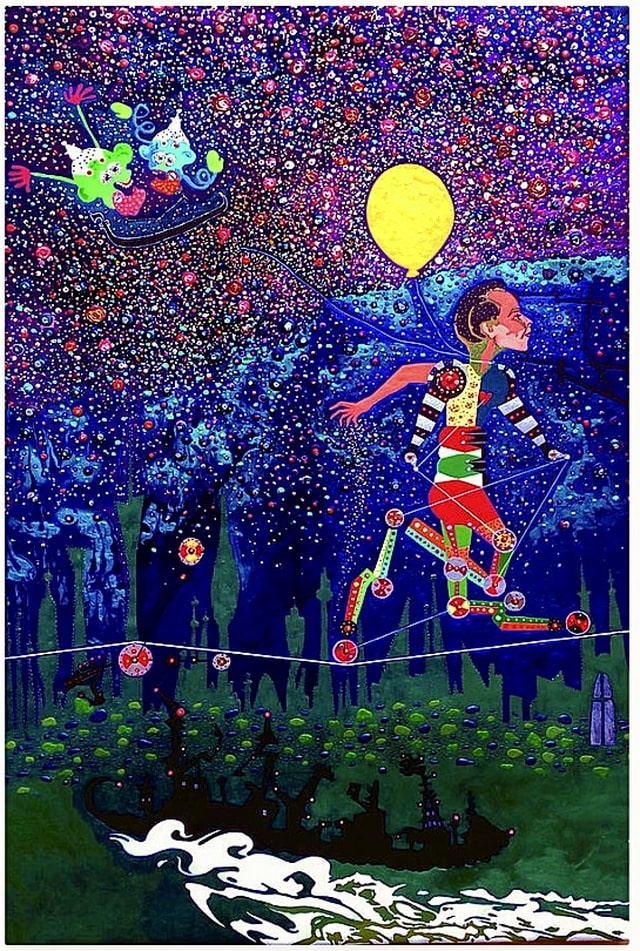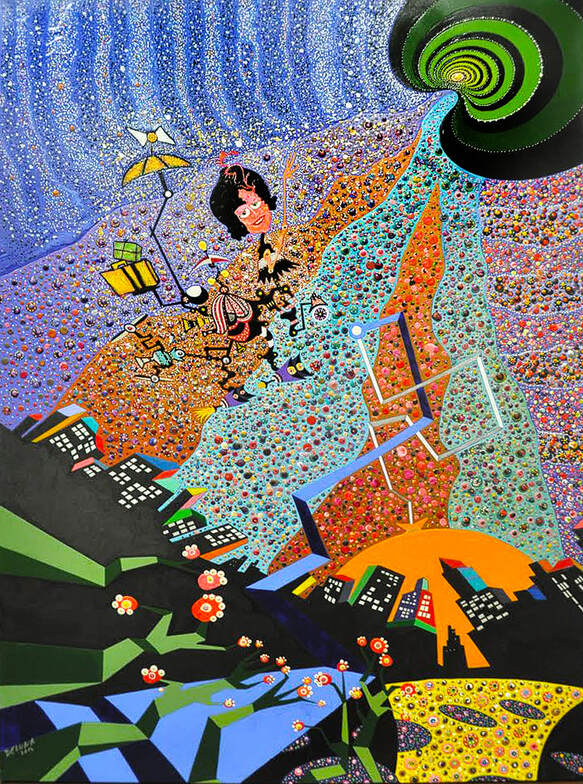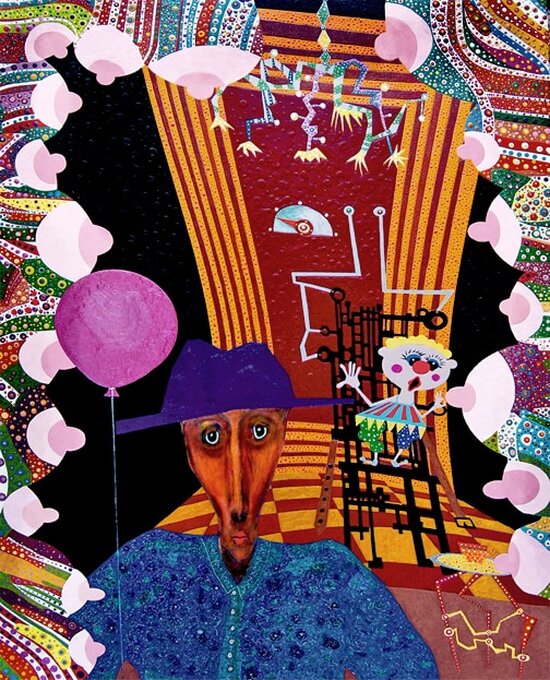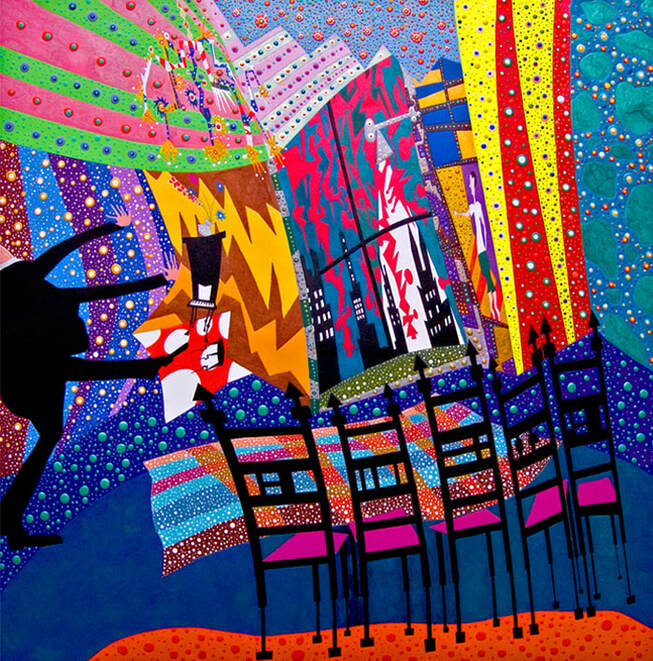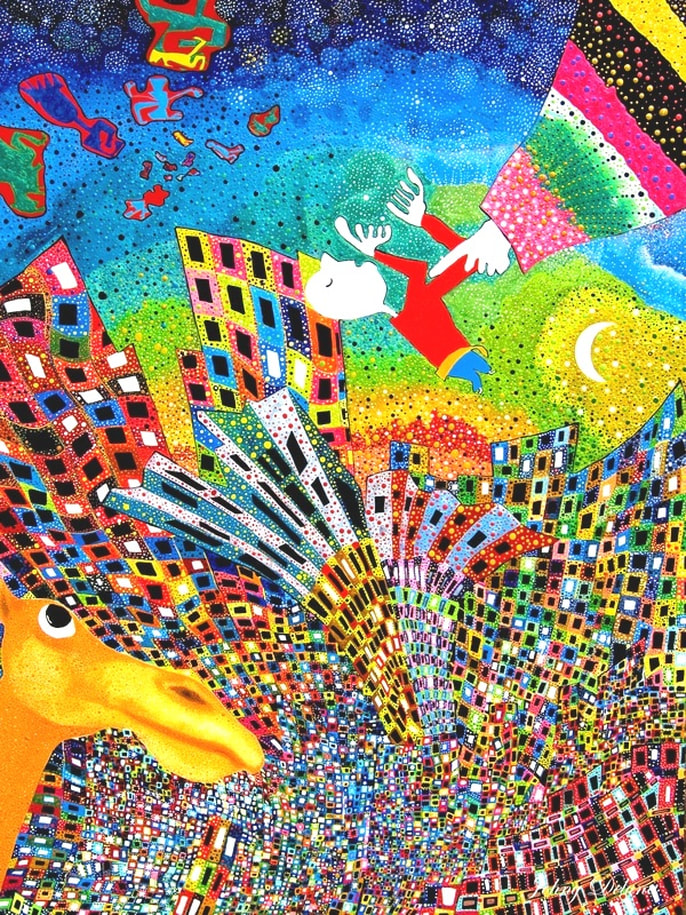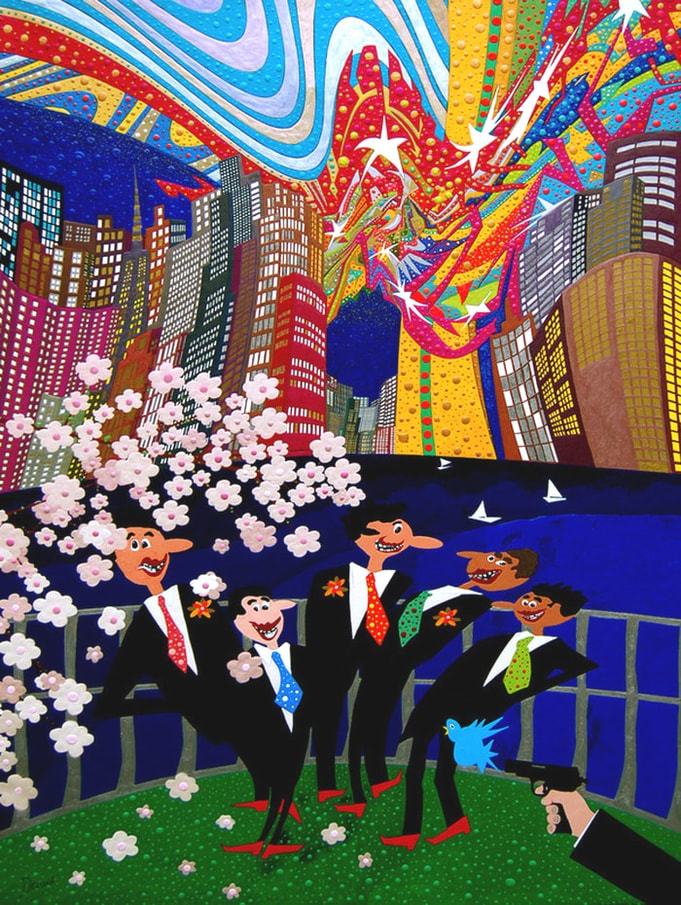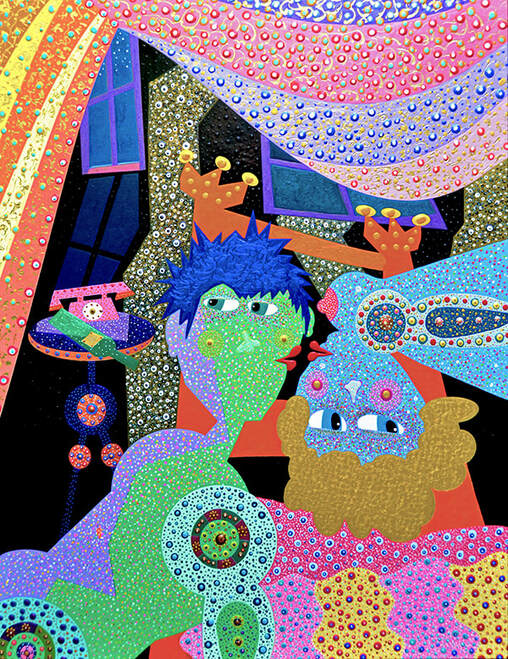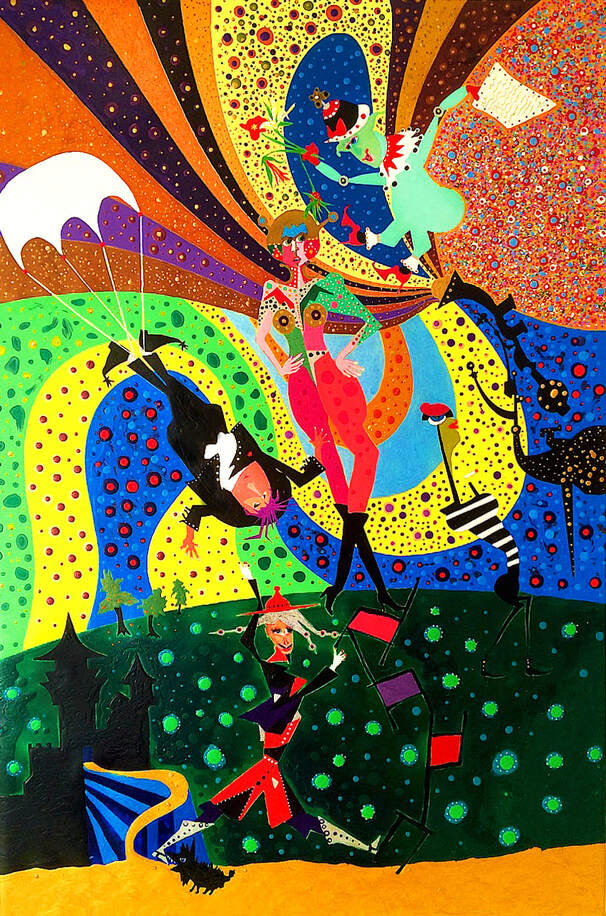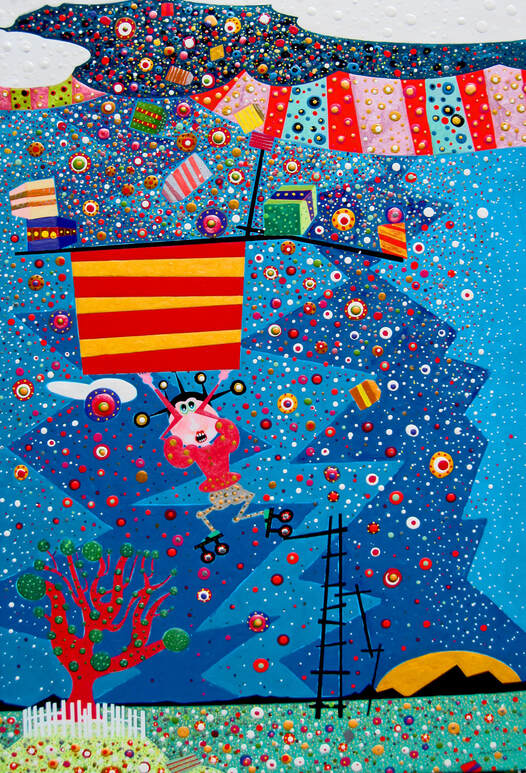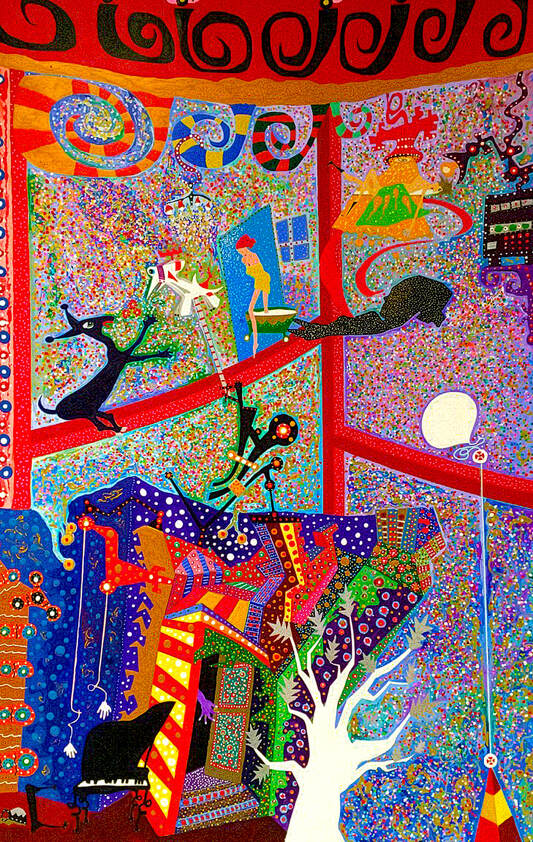
|
JOHNY DELUNA
e-mail - [email protected]
Join me on facebook - https://www.facebook.com/johnydelunaart/ _________________________________________ Canadian sales La Parete Gallery - [email protected] T. 416-533-8292 _________________________________________ I believe that humor is the best way to connect with others, because if we can laugh at ourselves there is still hope. As an artist, the only thing I can do is be honest, brave and stay true to my vision Creo que el humor es la mejor forma de conectar con los demás, porque si podemos reírnos de nosotros mismos todavía hay esperanza. Como artista, lo único que puedo hacer es ser honesto, valiente y ser fiel a mi visión. |
|
Johny Deluna is a Canadian artist of extraordinary coloristic and humorous talent.
His pictorial satire of surrealist interpretation depicts contemporary urban society and its relationship with nature, the cosmos and God. The connection with the art of Chagall and Dali is evident. The metamorphic human figures are represented as half-man and half-octopus and the persons with legs transformed into stilts so as not to tread on the ground, can connect with the divine. The compositions are divided into areas painted with the most stable clear surfaces that remember the background liberty of Klimt represent the shades of nature such as earth and water - the habitat of life, over which the clouds expressed in the dotted style of Seurrat. His own satirical self-image always appears in the artworks, creating the figure of witness and the storyteller of each fairy tale, painted and alluding to the style of Antonio Possenti. The flying and abducted characters like kites reminiscent of Chagall's paintings, point out the actual trivial importance of our earthly problem and unpredictability of nature, which like a whirlpool absorbs everything,. Everything is in perpetual motion, and the bay of unpredictable winds, represented by sparkling dots of pure colors that are placed next to one another, can give rise to different nuances according to the angle of view. Just as in life nothing is constant and everything is constantly changing .The atmosphere, space, and the cosmos, take over all of our earthly problems by reflecting on the fragility of our human existence. The pictorial satire, while recalling Chagall's and Possenti's art in its similarity of representation, draws some thoughts to the Renaissance humanist philosophy for example, "carpe diem" and "memento mori", inviting us to laugh at our problems, always finding a humorous point of view in everything; because as Lorenzo il Magnifico said in his Bacco song “ of tomorrow there is no certainty - Margherita Blonska - Italy - ------------------------------------------- Johny Deluna es un artista canadiense de extraordinario talento colorístico y humorístico. Su sátira pictórica de interpretación surrealista describe la sociedad urbana contemporánea y su relación con la naturaleza, el cosmos y Dios. La conexión con el arte de Chagall y Dalí es evidente. Las figuras humanas metamórficas están representadas como mitad hombre y mitad pulpo y el personas con piernas transformadas en zancos para no pisar el suelo, pueden conectarse con lo divino. Las composiciones se dividen en zonas pintadas con las superficies claras más estables que recuerda que la libertad de fondo de Klimt representa las sombras de la naturaleza como la tierra y el agua - el hábitat de la vida, sobre el que las nubes se expresan en el estilo punteado de Seurrat. Su propia satírica la propia imagen siempre aparece en las obras de arte, creando la figura del testigo y el narrador de cada cuento de hadas, pintado y alusivo al estilo de Antonio Possenti. Los voladores y abducidos personajes como cometas que recuerdan las pinturas de Chagall, señalan la importancia trivial real de nuestro problema terrenal y la imprevisibilidad de la naturaleza, que como un remolino lo absorbe todo,. Todo está en perpetuo movimiento, y la bahía de vientos impredecibles, representada por chispeantes puntos de colores puros que se colocan uno al lado del otro, pueden dar lugar a diferentes matices según al ángulo de visión. Así como en la vida nada es constante y todo está en constante cambio. atmósfera, el espacio y el cosmos, se hacen cargo de todos nuestros problemas terrenales al reflexionar sobre el fragilidad de nuestra existencia humana. La sátira pictórica, recordando el arte de Chagall y Possenti en su similitud de representación, atrae algunas reflexiones a la filosofía humanista renacentista para ejemplo, "carpe diem" y "memento mori", invitándonos a reírnos de nuestros problemas, encontrando siempre un punto de vista humorístico en todo; porque como decía Lorenzo il Magnifico en su canción de Bacco “de mañana no hay certeza - Margherita Blonska - Italia - |
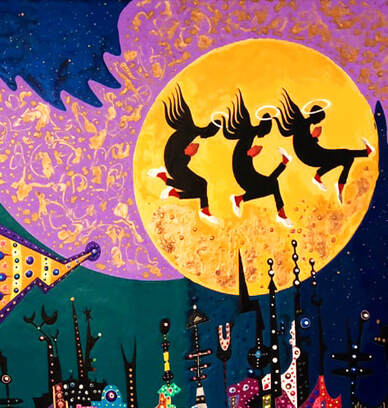
The Canadian artist Johny Deluna was an orphan. He started his artistic journey as a child of 4 when he was taken for a drive to get ice-cream, then left in a new house with total strangers. The woman who became his adopted mother saw that he was in total shock as he sat alone at the kitchen table. She gave him a little paint set and he pushed water colours around on the papers in front of him. He repeated this activity hundreds of times, day after day.
Not surprisingly, he grew up with great anger and distrust of adults and authority figures. Painting was his only refuge. As a child he had no control of anything in his life except his art so he became the "god of his pictures". He could create and interpret the world in the way he wanted to see it without the intervention of anyone else.
To this day, in his pictures tell important stories about our world and about profound topics that move him. He succeeds as both an artist and philosopher in wrapping serious themes in aesthetically appealing and colourful images. When seen in a large group, his paintings are a riot of colours and ideas. But they have exciting and unpredictable effects on the audience. One sees exuberant children who gleefully discover funny and beautiful creatures and events in his pictures.
Whereas, some adults are drawn to tears and others feel compelled to tell him about their own life struggles.
Whatever they experience, they return again and again to their favourite pieces. Deeply moved, they recognize their own life story told in them. Thus, the dramatic life story of the artist is reflected in a fascinating field of tension in his work, in profound stories of a life-long philosophizing sage influenced by the never-lost mind of the childlike "God of pictures".
- Christian Schneeberger - Austria -
-----
El artista canadiense Johny Deluna era huérfano. Comenzó su viaje artístico cuando era un niño de 4 años cuando lo llevaron a dar un paseo para comprar un helado, luego lo dejaron en una casa nueva con completos extraños. La mujer que se convirtió en su madre adoptiva vio que estaba en total conmoción mientras se sentaba solo en la mesa de la cocina. Ella le dio un pequeño juego de pintura y él empujó acuarelas en los papeles que tenía delante. Repitió esta actividad cientos de veces, día tras día. No en vano, creció con gran ira y desconfianza hacia los adultos y las figuras de autoridad. La pintura era su único refugio. Cuando era niño, no tenía control de nada en su vida, excepto de su arte, por lo que se convirtió en el "dios de sus imágenes". Podía crear e interpretar el mundo de la manera que quería verlo sin la intervención de nadie más. Hasta el día de hoy, en sus cuadros cuenta importantes historias sobre nuestro mundo y sobre temas profundos que lo conmueven. Tiene éxito como artista y filósofo al envolver temas serios en imágenes coloridas y estéticamente atractivas. Cuando se ven en un grupo grande, sus pinturas son un derroche de colores e ideas. Pero tienen efectos emocionantes e impredecibles en la audiencia. Uno ve niños exuberantes que alegremente descubren criaturas y eventos divertidos y hermosos en sus imágenes. Considerando que, algunos adultos se sienten atraídos por las lágrimas y otros se sienten obligados a contarle sobre sus propias luchas en la vida. Independientemente de lo que experimenten, vuelven una y otra vez a sus piezas favoritas. Profundamente conmovidos, reconocen en ellos la propia historia de vida contada. Así, la dramática historia de vida del artista se refleja en un fascinante campo de tensión en su obra, en profundas historias de un sabio filosófico de toda la vida influenciado por la mente nunca perdida del infantil "Dios de las imágenes". - Christian Schneeberger - Austria -
____________________________________________
"Hi Johny,
Late last night, my friend and I were walking down the sidewalk, when we were stopped by the colours pouring out of your gallery. We went inside, and I was transported to a moment I will remember for the rest of my life.
I only met that friend for the first time hours before. You may remember us, I am a tall guy, and I asked you about your painting "going home". I believe she may have touched one of your paintings; we had enjoyed a few drinks before, I apologize.The moments we shared in your gallery gave me the most overwhelming feeling of pure love I have ever experienced, though temporary. Your art captured that vitality and multiplied it for us to witness. I left and I was absolutely speechless.
That moment was a culmination of everything life can offer,
and I can't thank you enough for your art.
My name is Kevin her's is Layla.
Thank you. "
"Hola Johny, Anoche, mi amigo y yo caminábamos por la acera cuando nos detuvieron los colores que salían de tu galería. Entramos y fui transportado a un momento que recordaré por el resto de mi vida. Solo conocí a ese amigo por primera vez horas antes. Quizás te acuerdes de nosotros, soy un tipo alto, y te pregunté por tu cuadro "regresando a casa". Creo que pudo haber tocado uno de sus cuadros; habíamos disfrutado de unos tragos antes, te pido disculpas. Los momentos que compartimos en tu galería me dieron la sensación más abrumadora de amor puro que jamás haya experimentado, aunque sea temporal. Su arte capturó esa vitalidad y la multiplicó para que nosotros lo atestigüáramos. Me fui y me quedé absolutamente sin palabras. Ese momento fue la culminación de todo lo que la vida puede ofrecer, y no puedo agradecerte lo suficiente por tu arte. Mi nombre es Kevin, el de ella es Layla. Gracias. "
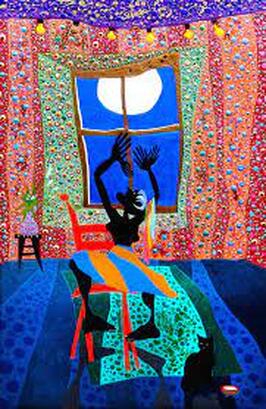
Miami Sun
SmithsonianLunar Art and Humanity
Written by Clifford Cunningham
Monday, 19 June 2017 01:18
A recent exhibit in Toronto showcased the extraordinary talent and humanistic wisdom of Johny Deluna. This Toronto-based artist gave me an exclusive interview, during which we concentrated on just two of his many thought-provoking canvases.
The Song to the Moon painting is inspired by a lovely song from the opera Rusalka, by Dvorak.
“Everything I paint about is largely about human activity,” said DeLuna. “To me this woman hugs the Moon, she can't get enough of it. She almost wants to own it: she has 4 hands to pull the Moon, coaxing it down. But it's an exercise in futility, rather than enjoying it, whereas the cat has his own little Moon in the bowl and is very content. So it is a dichotomy between wanting to enjoy the Moon or possess it.”
I also asked him about Selling the Moon, depicted here. “Every insect, every bird, every tree that disappears: we don't see it directly but it's happening and it's happening so fast we have no way of knowing. We don't even know the stuff that's disappearing because it hasn't been discovered. I think the biggest mass extinction benefit would be for humans to go: everything else would survive quite well.”
DeLuna regards the painting “as a statement about people thoughtlessly doing something. These people have been told 'box up the Moon, and ship it to wherever'. There will be a hole in the sky but we'll patch it up, put a sticker on it. But people have to bear the consequences of ripping the Moon out of the sky. The elephant symbolizes but just humanity but every creature that is going to be affected by our careless, greedy behaviour.”
While his paintings cover a much wider range than the lunar motif, I have concentrated on these due to my own interest in astronomy and art. I recommend looking at his wider catalogue of paintings, each of which contains hidden delights.
Art lovers interested in contacting Mr. DeLuna may do so through his email:
[email protected]
Dr. Clifford Cunningham is a planetary scientist. He earned his PhD in the history of astronomy at the University of Southern Queensland, and has undergraduate degrees in science and ancient history from the University of Waterloo. In 2014 he was named a contributor to Encyclopedia Britannica. He is the author of 14 books on asteroids and the history of science. In 1999 he appeared on the TV show Star Trek: Deep Space Nine. Asteroid 4276 was named in his honor in 1990 by the International Astronomical Union based on the recommendation of its bureau located at Harvard-Smithsonian Center for Astrophysics.
NOTICIAS DEL SOL MIAMI
Arte Lunar y Humanidad
Escrito por Clifford Cunningham Lunes, 19 Junio 2017 01:18
MERCADOS
Una exhibición reciente en Toronto mostró el extraordinario talento y la sabiduría humanista de Johny Deluna. Este artista con sede en Toronto me concedió una entrevista exclusiva, durante la cual nos concentramos en solo dos de sus muchos lienzos que invitan a la reflexión.
El cuadro Canción a la Luna está inspirado en una hermosa canción de la ópera Rusalka, de Dvorak.
“Todo lo que pinto trata en gran medida sobre la actividad humana”, dijo DeLuna. “Para mí, esta mujer abraza a la Luna, no se cansa de ella. Casi quiere poseerla: tiene 4 manos para tirar de la Luna, engatusándola hacia abajo. Pero es un ejercicio de futilidad, en lugar de disfrutarlo, mientras que el gato tiene su pequeña luna en el cuenco y está muy contento. Entonces es una dicotomía entre querer disfrutar de la Luna o poseerla”.
También le pregunté sobre Selling the Moon, representado aquí. “Cada insecto, cada pájaro, cada árbol que desaparece: no lo vemos directamente pero está pasando y está pasando tan rápido que no tenemos forma de saberlo. Ni siquiera sabemos las cosas que están desapareciendo porque no se han descubierto. Creo que el mayor beneficio de la extinción masiva sería que los humanos se fueran: todo lo demás sobreviviría bastante bien”.
DeLuna considera la pintura “como una declaración sobre personas que hacen algo sin pensar. A estas personas se les ha dicho 'empaquen la Luna y envíenla a donde sea'. Habrá un agujero en el cielo, pero lo arreglaremos, le pondremos una pegatina. Pero la gente tiene que soportar las consecuencias de arrancar la Luna del cielo. El elefante simboliza solo a la humanidad, pero a todas las criaturas que se verán afectadas por nuestro comportamiento descuidado y codicioso”.
Si bien sus pinturas cubren una gama mucho más amplia que el motivo lunar, me he concentrado en estas debido a mi propio interés en la astronomía y el arte. Recomiendo mirar su amplio catálogo de pinturas, cada una de las cuales contiene delicias ocultas.
Los amantes del arte interesados en contactar al Sr. DeLuna pueden hacerlo a través de su correo electrónico:
[email protected]
El Dr. Clifford Cunningham es un científico planetario. Obtuvo su doctorado en historia de la astronomía en la Universidad del Sur de Queensland y tiene títulos universitarios en ciencias e historia antigua de la Universidad de Waterloo. En 2014 fue nombrado colaborador de la Enciclopedia Británica. Es autor de 14 libros sobre asteroides y la historia de la ciencia. En 1999 apareció en la televisión espectáculo Star Trek: Espacio Profundo Nueve. El asteroide 4276 fue nombrado en su honor en 1990 por la Unión Astronómica Internacional en base a la recomendación de su oficina ubicada en el Centro de Astrofísica Harvard-Smithsonian.
SmithsonianLunar Art and Humanity
Written by Clifford Cunningham
Monday, 19 June 2017 01:18
A recent exhibit in Toronto showcased the extraordinary talent and humanistic wisdom of Johny Deluna. This Toronto-based artist gave me an exclusive interview, during which we concentrated on just two of his many thought-provoking canvases.
The Song to the Moon painting is inspired by a lovely song from the opera Rusalka, by Dvorak.
“Everything I paint about is largely about human activity,” said DeLuna. “To me this woman hugs the Moon, she can't get enough of it. She almost wants to own it: she has 4 hands to pull the Moon, coaxing it down. But it's an exercise in futility, rather than enjoying it, whereas the cat has his own little Moon in the bowl and is very content. So it is a dichotomy between wanting to enjoy the Moon or possess it.”
I also asked him about Selling the Moon, depicted here. “Every insect, every bird, every tree that disappears: we don't see it directly but it's happening and it's happening so fast we have no way of knowing. We don't even know the stuff that's disappearing because it hasn't been discovered. I think the biggest mass extinction benefit would be for humans to go: everything else would survive quite well.”
DeLuna regards the painting “as a statement about people thoughtlessly doing something. These people have been told 'box up the Moon, and ship it to wherever'. There will be a hole in the sky but we'll patch it up, put a sticker on it. But people have to bear the consequences of ripping the Moon out of the sky. The elephant symbolizes but just humanity but every creature that is going to be affected by our careless, greedy behaviour.”
While his paintings cover a much wider range than the lunar motif, I have concentrated on these due to my own interest in astronomy and art. I recommend looking at his wider catalogue of paintings, each of which contains hidden delights.
Art lovers interested in contacting Mr. DeLuna may do so through his email:
[email protected]
Dr. Clifford Cunningham is a planetary scientist. He earned his PhD in the history of astronomy at the University of Southern Queensland, and has undergraduate degrees in science and ancient history from the University of Waterloo. In 2014 he was named a contributor to Encyclopedia Britannica. He is the author of 14 books on asteroids and the history of science. In 1999 he appeared on the TV show Star Trek: Deep Space Nine. Asteroid 4276 was named in his honor in 1990 by the International Astronomical Union based on the recommendation of its bureau located at Harvard-Smithsonian Center for Astrophysics.
NOTICIAS DEL SOL MIAMI
Arte Lunar y Humanidad
Escrito por Clifford Cunningham Lunes, 19 Junio 2017 01:18
MERCADOS
Una exhibición reciente en Toronto mostró el extraordinario talento y la sabiduría humanista de Johny Deluna. Este artista con sede en Toronto me concedió una entrevista exclusiva, durante la cual nos concentramos en solo dos de sus muchos lienzos que invitan a la reflexión.
El cuadro Canción a la Luna está inspirado en una hermosa canción de la ópera Rusalka, de Dvorak.
“Todo lo que pinto trata en gran medida sobre la actividad humana”, dijo DeLuna. “Para mí, esta mujer abraza a la Luna, no se cansa de ella. Casi quiere poseerla: tiene 4 manos para tirar de la Luna, engatusándola hacia abajo. Pero es un ejercicio de futilidad, en lugar de disfrutarlo, mientras que el gato tiene su pequeña luna en el cuenco y está muy contento. Entonces es una dicotomía entre querer disfrutar de la Luna o poseerla”.
También le pregunté sobre Selling the Moon, representado aquí. “Cada insecto, cada pájaro, cada árbol que desaparece: no lo vemos directamente pero está pasando y está pasando tan rápido que no tenemos forma de saberlo. Ni siquiera sabemos las cosas que están desapareciendo porque no se han descubierto. Creo que el mayor beneficio de la extinción masiva sería que los humanos se fueran: todo lo demás sobreviviría bastante bien”.
DeLuna considera la pintura “como una declaración sobre personas que hacen algo sin pensar. A estas personas se les ha dicho 'empaquen la Luna y envíenla a donde sea'. Habrá un agujero en el cielo, pero lo arreglaremos, le pondremos una pegatina. Pero la gente tiene que soportar las consecuencias de arrancar la Luna del cielo. El elefante simboliza solo a la humanidad, pero a todas las criaturas que se verán afectadas por nuestro comportamiento descuidado y codicioso”.
Si bien sus pinturas cubren una gama mucho más amplia que el motivo lunar, me he concentrado en estas debido a mi propio interés en la astronomía y el arte. Recomiendo mirar su amplio catálogo de pinturas, cada una de las cuales contiene delicias ocultas.
Los amantes del arte interesados en contactar al Sr. DeLuna pueden hacerlo a través de su correo electrónico:
[email protected]
El Dr. Clifford Cunningham es un científico planetario. Obtuvo su doctorado en historia de la astronomía en la Universidad del Sur de Queensland y tiene títulos universitarios en ciencias e historia antigua de la Universidad de Waterloo. En 2014 fue nombrado colaborador de la Enciclopedia Británica. Es autor de 14 libros sobre asteroides y la historia de la ciencia. En 1999 apareció en la televisión espectáculo Star Trek: Espacio Profundo Nueve. El asteroide 4276 fue nombrado en su honor en 1990 por la Unión Astronómica Internacional en base a la recomendación de su oficina ubicada en el Centro de Astrofísica Harvard-Smithsonian.
A few sketches and experiments








